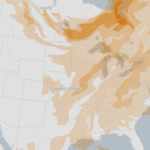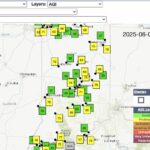Welcome to the start of Hurricane Season that runs from June through November each year. Why would Indiana care about hurricane season? Certainly, by the time any hurricane might impact the state, it will have been greatly downgraded to what is called an extratropical (i.e., poleward of the Tropic of Cancer (23.5° north latitude)) storm or the remnants of the hurricane. Regardless, these hurricane remnant storms can bring often-needed rainfall with enough moisture to potentially be drought busters.
While our first tropical storm of 2025 (would be named “Andrea”) has yet to develop, forecasters are keeping an eye on strong wind patterns coming from western Africa and areas of low pressure that could strengthen to tropical storm levels (maximum sustained surface winds reaching 39-73 mph (34-63 knots)).
Speaking of those easterly winds coming from western Africa, another reason why Indiana may be interested in these and other tropical storm patterns is due to massive Saharan dust storms that can be carried thousands of miles across the Atlantic Ocean. There is currently a massive dust cloud, fed by the Sahara Desert and carried by the northeast trade winds, that is headed our way (Science Alert). AccuWeather provides a fun animation of the size and path of this dust storm that is currently impacting the Caribbean Sea and is projected to steer northward into the United States from the Gulf region (AccuWeather). Depending upon how far north this dust plume goes, we may see hazy skies that are likely to reduce the amount of solar radiation reaching our surface.
Smoke from Canadian wildfires is also creating hazy skies across Indiana. The National Oceanic and Atmospheric Administration (NOAA) provides an experimental smoke forecast product that predicts smoke intensity for the next 48 hours. The New York Times offered a color-shaded product of the NOAA tool, as shown in Figure 1. As long as the wildfires continue burning and upper-atmospheric winds continue to steer the smoke southeastward, we can expect hazy skies across our area.
How do hazy skies impact crop production? There are both positive and negative impacts. As mentioned, smoky skies can block incoming solar radiation that is necessary for photosynthetic development. However, the reduced solar radiation can also reduce daytime heating by several degrees causing a reduction in evapotranspiration and other possible drought impacts. Smoke and dust particles – depending upon their concentration – also service as cloud condensation nuclei (i.e., particles that water vapor can condense on to). With the right amount of suspended particles and water vapor in the air, cloud droplet may grow enough to cause precipitation – another important component to crop production. On the other hand, too many suspended particles could simply haze up the sky without encouraging those cloud droplets to grow.
Finally, smoke and dust can create health hazards, particularly for the elderly and those vulnerable to respiratory ailments. Be sure to monitor the Indiana Department of Environmental Management’s near real-time air quality maps and data to assess air quality risk levels for your area before spending too much time outdoors. Figure 2 provides an example of one of their maps.
- Figure 1. Example of the NOAA experimental forecast product showing smoke intensity for 3 PM EDT on Wednesday, June 4, 2025. Product enhance by the New York Times.
- Figure 2. Example output from the Indiana Department of Environmental Management’s near real-time air quality map. ( https://www.in.gov/idem/airmonitoring/air-quality-data/)

